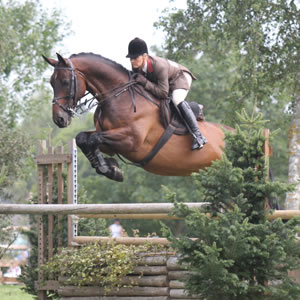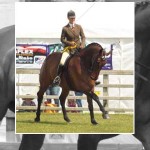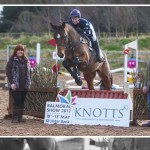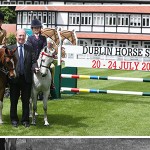All Your Showing Questions Answered with Toni Donnelly
Toni Donnelly has been pioneering the way with her showing clinics all over Ireland this year, visiting different riding clubs and groups each week to introduce the world of showing to a new audience.
Toni Donnelly and Majestic Gold
at the Balmoral Show last year.
Through her enthusiastic approach and appearing in the headlines on a weekly basis this year, Toni has just been named as a brand ambassador for Spillers Horse Feeds.
We learnt a lot from Toni’s Q & A and we hope you do to as it not looks at such a wide variety of classes it is sure to encourage you onto the showing circuit should you not have already planned to compete!
Click here for a list of showing dates (including Toni’s showing clinics) for the months ahead.
The decision of which class to enter your horse into can be a daunting one, as it can make the difference between the top and bottom of the line up. This is why Toni Donnelly’s experienced eye has helped to introduce lots of new competitors to the world of showing and given them the confidence and knowledge to brave it onto their local grass arena for their showing debut.
Showing classes are divided into different weight sections: lightweight, middleweight, heavyweight and horse types including small hunter, riding horse and cob classes.
What would you describe as a perfect lightweight hunter?
Seven-eighths or full thoroughbred, to carry 12st 7Ib with a height of 16hh – 16.2hh, 8.5 inches of bone (cannon bone) Lots of presence and well-schooled
What would you be looking for in a Middleweight Hunter?
16.3hh and carry up to 14 stone, with about 8 3/4 to 9 inches of bone, elegant and mannerly
Would a heavyweight hunter be ideally larger in height aswell as overall stature?
Yes, ideally, 17hh, carry over 14stone, should have 9 – 10 inches of bone. Handsome looks and good paces.
What is the height restriction for a small hunter and what condition should they ideally be?
Measured 15.2hh, a mini middleweight with quality and manners. They must be measured by SJAI and stamped on passport.
What about coloured classes? Is there a specific height and build?
They can be any size and usually have to be registered with CHAPS
Should ponies be plaited for native classes?
NO! Please DO NOT PLAIT NATIVES. They should be registered with their breed society and Connemara’s classes can be ridden by adult and be over 14.2cm for some classes.
What is the difference between a riding horse and ridden hunter?
A riding horse will have less bone and be very elegant, the small class is for horses exceeding 14.2hh but not exceeding 15.2hh and the large which is for animals exceeding 15.2hh and with no upper height limit. Horses should wear a coloured brow band.
Is there a height for the lightweight cob class?
The lightweight cob should not exceed 15.1hh and have at least 8″ of bone below the knee, while a heavyweight is classified to carry 14 stone or over at 15.1hh.
Should there be any difference in tack for these two classes?
You would use a wider leather in the bridle, i.e. a large flat noseband. They must also be measured by SJAI and have their height stamped on their passport.
 Toni Donnelly and Majestic Gold in the HOYS Working Hunter FinalWhat is the definition of a show working hunter?
Toni Donnelly and Majestic Gold in the HOYS Working Hunter FinalWhat is the definition of a show working hunter?
The definition of a show working hunter is a good-looking horse that jumps smoothly and quietly. He should be well schooled with correct conformation, athletic movement and a good, level temperament.
At county level shows classes are divided into small hunter, novice / young horse classes 90cm and open 1m upwards. Height will always be stated on schedules. Indoor shows different have classes according to height of fences.
Small hunters and Cobs will jump a course of rustic style fences with jump height between 80cm -90cm
What height do four year old horses jump?
Four year old horses would jump up to 80cm
What is the correct rider attire for hunter classes?
Rider dress for all hunter classes is tweed jackets, tan cloured gloves and riding hats, cream, canary or beigebreeches, a cream shirt with a tie (and tie pin) tall black riding boots. Show canes are generally carried. Use elastic string for numbers and a nice tip is to cut the corners off your numbers. Should wear spurs or dummy spurs.
For evening championships, lady riders should wear a black or navy jacket (men pink jacket) with a white or cream stock, fastened with a pin, plus a top hat,
What should competitors NOT wear?
No STOCKS, or Chaps or flowers on jackets.
So down to the horse, what tack should be used and how should the horse be turned out?
All tack should be brown or black and matching, for showing classes tack should be plain and flat, but for working hunter classes it can be raised. Dark fitted numnahs and girths.
Showing saddles are straight cut. Working hunter saddles can be general purpose, however a handy hint is tomake sure the stirrups are big enough for a man’s foot and that you have enough holes in your saddle’s leathers for a short legged judge!
Double bridles are only used for showing classes over 4 years of age, snaffles for 4 yr olds if required. Always have a plaited rein on the bridoon or thinner rein on Weymouth / curb bit. No gag bits are allowed in working hunter, use understated simple bridles. Martingales are ok for working hunter. Double bridles can be used in Open classes, and boots for jumping phase only.
Now to turnout of the horse…
The horse must be well groomed, with heels, ears and muzzle trimmed, tail plaited or pulled, mane plaited with same colour bands or thread as the colour of the hair. Plaits are larger and fewer than for show jumping or dressage. Hoof oil on feet, with quarter marks for showing classes. Tails cut about 1.5 inches below chestnut.
Pony Showing Classes
The Lead Rein Pony, is there a particular age for the child and what tack should be worn?
Ponies suitable for a child of three to seven years of age are ideal. The ponies must be shown in snaffle bridles with the lead rein attached to the noseband. Judges will be looking for a pony with correct conformation, good movement, a good front and with perfect manners.
What will the judge be looking for in a ridden pony?
The First Ridden Pony
The pony should be four years old and over and must not exceed 122cms. They are to be ridden by children up to ten years of age and again must be shown in snaffle bridles. These ponies are required to walk and trot when all together. They are asked to canter during their individual show, and the judge will be looking for a well-mannered pony which goes quietly and freely forward with the child in charge of the situation.
The 128cms (12.2hh) Ridden Show Pony
This class is for ponies four years old and over which does not exceed 128cms and ridden by a child up to thirteen years of age. In the class the judges will expect a quality, well-mannered pony which, in their opinion, is suitable for a youngster to show. The top 12.2hh pony should be more refined than the first-ridden and should include a change of rein at the canter and a few strides of gallop during the individual show
The 138cms (13.2hh) Ridden Show Pony
This class is for ponies exceeding 128cms but not exceeding 138cms and ridden by children up to fifteen years of age. It is one of the strongest classes to win with some of the most correct and beautifully bred ponies in it. At this height the judges will be looking for ponies that really cover the ground and which are polished and fluent in their individual shows.
The 148cms Class
This show pony class is for ponies exceeding 138cms and not exceeding 148cms ridden by children up to seventeen years of age. It should be forward-going, bold in its outlook and able to gallop really well and give individual shows that are completely in control and a pleasure to watch.
The Intermediate Show Riding Types are typically divided into two classes: exc. 146cms but not exc. 153cms and exc. 153cms but not exc. 158cms. Both these classes are for riders up to 25 years of age. The above bridles would have coloured brow bands and refined leather to show off the pony’s head properly and the child should be wearing navy (g) or black (b) jackets with a flower for girls.
The Show Hunter Pony classes have become very popular. The ideal pony for this class will have the correct conformation and be a miniature of the show hunter. So more stocky / chunky ponies ideally Connemara x’s. The same type for the W.H classes. Bridles are plain brown and thicker leather in double bridles for showing classes.
There are four height groups:
Not to exceed 122cms for riders up to the age of eleven
Exceeding 122cms but not exceeding 133cms
For riders up to the age of fourteen, exceeding 133cms but not exceeding 143cms.
For riders up to the age of seventeen and exceeding 143cms but not exceeding 153cms for riders up to the age of twenty.
As with the Show Pony classes several new classes have been added over the years: Novice, Restricted, Mixed Height and Intermediates. The Intermediate Show Hunter Type classes are for ponies/horses exceeding 148cms but not exceeding 158cms and are for riders up to the age of twenty five, and these too have proved very popular with many top class Small Hunters competing with younger riders

Left to right: Evanne McKenna riding Bella, Sharon McKeever and Cosmic Rolo, Paul Clancy and Blueberry, Sara McAree – Rosie, Michelle Clancy – Le Hoss, Shona Greg – Peppe
Toni and her students at a recent working hunter clinic in Lusks Equestrian Centre.
We would like to say a huge thank you to Toni Donnelly for explaining each class with such great detail, we have learnt a lot and can clearly see why her clinics are proving so popular as new dates grace our diary dates pages frequently from all over Ireland.
If you would like to know more including information on the working hunter pony and classes at the working hunter festival and qualifiers for this type of pony or native breeds, please contact Toni to arrange a clinic or lesson or to even find out when her clinics are near you so you can attend and learn more about your own horse or pony and how to show it to its full potential.
Toni Donnelly BSc. HND Eq, BHSAI, I.S.A & I.W.H.A Judge
antonia.donnelly@btinternet.com or Tel: 07764 786 500
Category: Business Features, Disciplines, Events, Features











